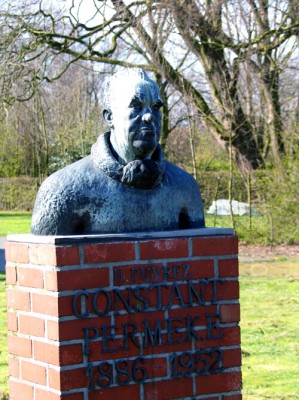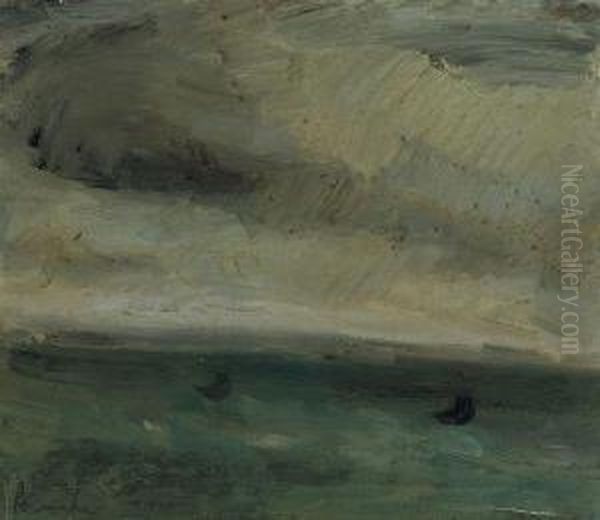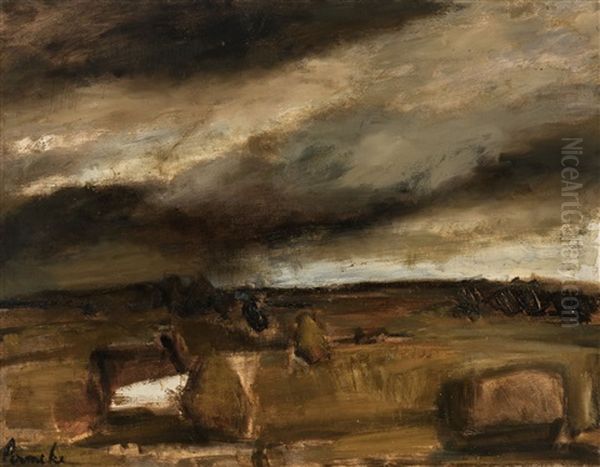
Constant Permeke stands as a monumental figure in 20th-century European art, particularly renowned as the leading force behind Flemish Expressionism. A Belgian national, born in Antwerp on July 31, 1886, and passing away in Ostend on January 4, 1952, Permeke dedicated his life to capturing the raw essence of human existence through the powerful mediums of painting and sculpture. His work delves deep into the lives of ordinary people – fishermen, farmers, labourers – portraying their struggles, resilience, and profound connection to the earth and sea with an unflinching honesty and emotional depth that continues to resonate today.
Early Life and Artistic Awakening
Permeke's immersion in the art world began at a young age. His father, Henri Permeke, was a landscape painter and later served as the curator of the Municipal Museum in Ostend, where the family moved when Constant was six. This environment undoubtedly nurtured his artistic inclinations. His formal training commenced at the Bruges Academy from 1903 to 1906, followed by studies at the Ghent Academy of Fine Arts between 1906 and 1908. These formative years were crucial not only for honing his technical skills but also for forging connections that would shape the course of Belgian modern art.
During his time in Ghent, Permeke encountered fellow artists who would become key figures in Flemish Expressionism, most notably Frits van den Berghe and Gustave De Smet. Together, they were drawn to the artistic community flourishing in the rural village of Latem-Saint-Martin, near Ghent. This area became a crucible for artistic experimentation, attracting artists seeking to break away from academic constraints and Impressionist aesthetics. Influenced by Symbolism and a desire for more profound, subjective expression, the artists of the first Latem school, including figures like Gustave van de Woestyne and Valerius De Saedeleer, laid groundwork that Permeke and his contemporaries would build upon, pushing towards a more rugged, emotionally charged style.

The Latem-Saint-Martin experience was pivotal. The artists there explored non-naturalistic forms and colours, seeking to convey inner truths rather than mere surface appearances. They were inspired by the rural landscape and the lives of its inhabitants, themes that would become central to Permeke's own oeuvre. This period marked a departure from traditional representation, embracing a more direct, expressive approach that prioritized emotional impact over objective accuracy. The seeds of Flemish Expressionism were sown in this fertile ground of artistic camaraderie and shared exploration.
The Impact of War
The outbreak of World War I dramatically interrupted Permeke's burgeoning career and profoundly marked his life and art. Mobilized into the Belgian army, he served on the front lines. In 1914, near the town of Duffel, he sustained serious injuries during combat. Evacuated, he was transported to the United Kingdom for medical treatment, spending a significant portion of the war years recovering in South Devon. This period of enforced exile and confrontation with the brutality of war left an indelible scar.
His experiences during the war – the violence, the suffering, the displacement – deepened his understanding of the human condition and infused his subsequent work with a sense of gravity and empathy. While in England, he continued to draw and paint, often focusing on the landscapes around him but imbued with a somberness reflecting his inner state. The war stripped away any remaining vestiges of romanticism, reinforcing his commitment to portraying life in its most elemental and often harsh realities.
Upon his return to Belgium after the war, settling again in Ostend, the impact of his wartime experiences became evident in his art. His style grew bolder, his forms more monumental, and his palette often darker and more earthbound. He turned his attention with renewed focus to the lives of those who endured hardship – the fishermen battling the sea, the farmers toiling the land. Works from this period began to exhibit the full force of his expressionist vision, characterized by powerful lines, simplified forms, and a palpable sense of weight and struggle.
Forging Flemish Expressionism
Returning to Flanders, Permeke became a central figure in what is now recognized as Flemish Expressionism, a distinct branch of the broader European Expressionist movement. While sharing some affinities with German Expressionism, particularly in its emphasis on subjective experience and emotional intensity, the Flemish variant developed its own unique characteristics, deeply rooted in the local culture, landscape, and artistic traditions of Flanders. Artists like Permeke, Gustave De Smet, and Frits van den Berghe are considered its primary exponents.

Flemish Expressionism, as exemplified by Permeke, is often characterized by its connection to the earth, its monumental and sculptural treatment of the human figure, and a palette dominated by rich browns, ochres, and deep blacks. Unlike the sometimes more agitated or psychologically fraught works of German Expressionists like Ernst Ludwig Kirchner or Oskar Kokoschka, Permeke's art often possesses a grounded, almost primal quality. It speaks of endurance, resilience, and a deep, often somber, connection between humanity and nature.
Permeke's style solidified during the 1920s. His brushwork became thick and vigorous, applying paint in heavy layers that emphasized the physicality of his subjects and the act of painting itself. He simplified forms, reducing figures and landscapes to their essential structures, thereby enhancing their expressive power. His compositions are often bold and direct, confronting the viewer with the stark realities of the lives he depicted. He sought to capture not just the appearance, but the very soul and weight of his subjects.
Core Themes and Subjects
Throughout his career, Permeke remained deeply connected to the lives of the common people of Flanders. His primary subjects were the fishermen of the North Sea coast, the farmers working the fields, and their families. He portrayed their world without sentimentality, focusing on the physical labor, the harsh conditions, and the quiet dignity of their existence. The sea itself was a recurring and powerful motif, depicted not as a picturesque backdrop but as a formidable force of nature, shaping the lives of those who depended on it.
Works like The Stranger (1916), painted during his recovery, already hinted at the direction his art would take, depicting figures with a certain weight and introspection. Following the war, masterpieces such as The Oarsmen (1921) emerged, showcasing his mature style. This painting, with its powerful, almost brutally rendered figures straining at their oars, embodies the themes of struggle and human effort against overwhelming forces. Similarly, The Sower (both in painting and later sculpture) became an iconic representation of the connection between humanity and the agricultural cycle, a figure rooted in the earth he cultivates.
Permeke also explored themes of family, motherhood, and domestic life, again focusing on the essential, often challenging, aspects of these relationships. Paintings like The Betrothed (1923) or Daily Bread (1950) depict intimate moments, but always with a sense of gravity and monumentality. His figures possess a sculptural quality, their forms solid and enduring, suggesting a resilience forged through hardship. He avoided idealization, instead finding beauty and meaning in the unvarnished truth of everyday life. His landscapes, too, particularly his seascapes, convey a raw power, often dark and brooding, reflecting the untamed nature of the coastal environment he knew so well.
The Jabbeke Studio and the Turn to Sculpture
In 1929, seeking a closer connection to the rural landscape that inspired him, Permeke moved inland from Ostend to the village of Jabbeke, located between Bruges and Ostend. There, he commissioned the architect Pierre Vandervoort to design and build a unique modernist house and studio complex. Named "De Vier Winden" (The Four Winds), the building itself was a statement – a functional, avant-garde structure that reflected Permeke's own artistic spirit. It became his primary base for creation for the rest of his life.
The move to Jabbeke coincided with an increasing interest in sculpture. While he had experimented with the medium earlier, the 1930s saw him dedicate significant energy to three-dimensional work. His sculptures echo the concerns and style of his paintings: they are monumental, earthy, and deeply expressive. He often worked directly, carving into wood or modeling clay for bronze casting, retaining a sense of the raw material in the finished piece.
His sculptures frequently revisited themes familiar from his paintings. Figures like The Sower gained a powerful physical presence in bronze. He created compelling portraits and figure studies, such as the tender yet strong depiction of his daughter in Marie-Lou. One of his most famous late sculptures is Niobe (1951), a large bronze inspired by the tragic figure from Greek mythology. Even in tackling a classical theme, Permeke imbued the figure with his characteristic earthy monumentality and profound sense of sorrow and endurance, transforming the ancient myth into a universal statement about human suffering and resilience. Other notable sculptures include The Reaper and Fatima.
Artistic Circle, Influences, and Comparisons
Permeke was not an isolated figure. His development was intertwined with the artistic currents of his time and his interactions with fellow artists. The early association with the Latem-Saint-Martin group, including Gustave De Smet, Frits van den Berghe, Gustave van de Woestyne, and Valerius De Saedeleer, was fundamental in shaping the direction of Flemish Expressionism. They shared a desire to move beyond Impressionism and create a more meaningful, locally rooted modern art.
His deep friendship with Léon Spilliaert, another major Ostend-based artist, was also significant. Though Spilliaert's style, often associated with Symbolism and characterized by more linear and psychologically intense works, differed from Permeke's robust expressionism, they shared studio space for a time and a mutual interest in the coastal environment and its inhabitants. Their friendship highlights the rich artistic milieu of Ostend, which also included the towering figure of James Ensor, whose own expressive and often grotesque works prefigured Expressionism in Belgium.
While distinctly Flemish, Permeke's work can be situated within the broader context of European Expressionism. Comparisons are often drawn with German Expressionists like Emil Nolde or Ernst Ludwig Kirchner, who also employed bold forms and colours to convey intense emotion. However, Permeke's focus remained more consistently on the external world of labour and nature, rather than the urban anxieties or psychological fragmentation sometimes seen in German Expressionism. His work also resonates with the social realism and powerful figuration found in the art of French painter Georges Rouault or even the earlier works of Edvard Munch.
Permeke's influence extended to subsequent generations of artists. His powerful figuration and expressive handling of materials inspired younger Belgian artists like Jean Brusselmans and Edgard Tytgat, who continued to explore expressionist modes. Even artists working in different styles, such as the Dutch abstract painter Luc Peire, acknowledged the impact of Permeke's forceful representation of the human form during Peire's earlier figurative period in the 1950s. Permeke, alongside contemporaries like Rik Wouters (known for Fauvist influences), helped define Belgian modernism.
Later Years, Recognition, and "Degenerate Art"
Permeke continued to work prolifically through the 1930s and 1940s. During the German occupation of Belgium in World War II, his art, like that of many modernists, was deemed "Entartete Kunst" (Degenerate Art) by the Nazi authorities. This label led to restrictions and condemnation, forcing many artists associated with Expressionism and other avant-garde movements to work discreetly or face persecution. Despite these challenging circumstances, Permeke persisted in his creative endeavors at his Jabbeke studio.
After the liberation of Belgium, Permeke received significant recognition for his contributions to art. In 1945, he was appointed director of the National Higher Institute and Royal Academy in Antwerp, a prestigious position acknowledging his stature, although his heart remained in his Jabbeke studio. A major retrospective exhibition of his work was held in Antwerp in 1947, celebrating his career and cementing his reputation as a leading figure in Belgian art.
In his later years, Permeke continued to paint and sculpt, revisiting familiar themes with enduring power. His late painting Farewell (Het Afscheid, 1948) is a poignant work, depicting figures in a somber setting, handled with dramatic light and shadow, reflecting on themes of departure, life, and death. His final sculptures, like Niobe (1951), demonstrate his undiminished creative force. He remained committed to his vision until his death in 1952.
Legacy and Major Collections
Constant Permeke left behind a vast and powerful body of work, comprising hundreds of paintings, numerous sculptures, and a large collection of drawings and sketches. His legacy is that of a master craftsman and a profound humanist, an artist who gave voice to the toil and resilience of ordinary people and captured the raw beauty of the Flemish landscape. He is undeniably one of the most important Belgian artists of the 20th century and a key figure in the international story of Expressionism.
His former home and studio in Jabbeke, "De Vier Winden," was transformed into the Permeke Museum after his death. This museum, now part of Mu.ZEE, houses the largest single collection of his work, including paintings, sculptures, and drawings, displayed in the very spaces where they were created. It offers unparalleled insight into his life and artistic process. The museum underwent renovations and reopened in March 2024, reaffirming its importance as a centre for understanding Permeke's art, launching with an exhibition titled "Permeke against the Light."
Significant collections of Permeke's work are also held by other major Belgian institutions. Mu.ZEE in Ostend (which incorporated the former PMMK Bruges collection) holds a substantial collection, reflecting his strong ties to the coastal city. The Royal Museum of Fine Arts Antwerp (KMSKA) and the Royal Museums of Fine Arts of Belgium in Brussels also possess important examples of his paintings and sculptures, frequently featuring them in their permanent displays and temporary exhibitions. Works like Marine in Brussels exemplify his powerful seascapes. His art has also been exhibited internationally, including at institutions like the FeliXart Museum in Drogenbos, Belgium, and features in numerous private collections worldwide.
Enduring Significance
Constant Permeke's art transcends its specific time and place. While deeply rooted in the Flemish soil and the lives of its people, his work speaks to universal themes of human struggle, endurance, the power of nature, and the search for meaning in everyday existence. His unique blend of realism and expressionism, his monumental forms, and his earthy palette created a visual language that is both powerful and deeply moving.
He stands as a testament to the expressive potential of painting and sculpture, demonstrating how art can convey profound emotional and physical weight. His unwavering focus on the human condition, depicted without sentimentality but with deep empathy, ensures the enduring relevance of his work. Constant Permeke remains a titan of Flemish art, a crucial figure in European Expressionism, and an artist whose powerful vision continues to command attention and respect.